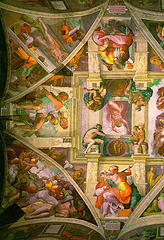
“Without having seen the Sistine Chapel one can form no appreciable idea of what one man is capable of achieving.” Goethe’s remark is kind but romantic — Michelangelo’s frescoes ennoble the human spirit, but they also illustrate the dangers of scope creep.
The painter signed on in 1508 to repaint the ceiling, at first with simple golden stars on a blue sky. Lacking a project manager, he agreed to add 12 figures, and the slide began. Before he was done there would be more than 300 figures, in scenes depicting the Creation, Adam and Eve in the Garden of Eden and the Last Judgment.
As the scale grew, problems multiplied. The Judgment drew objections from Cardinal Carafa, who was scandalized because now a fresco was showing human genitals inside the Vatican. And the artist was forced to make do with male models, because females were too rare and costly.
In short, the Renaissance was plagued by all the same devils that dog modern projects. At least Michelangelo met them philosophically and saw the project through. “If people only knew how hard I work to gain my mastery,” he said, “it wouldn’t seem so wonderful at all.”
